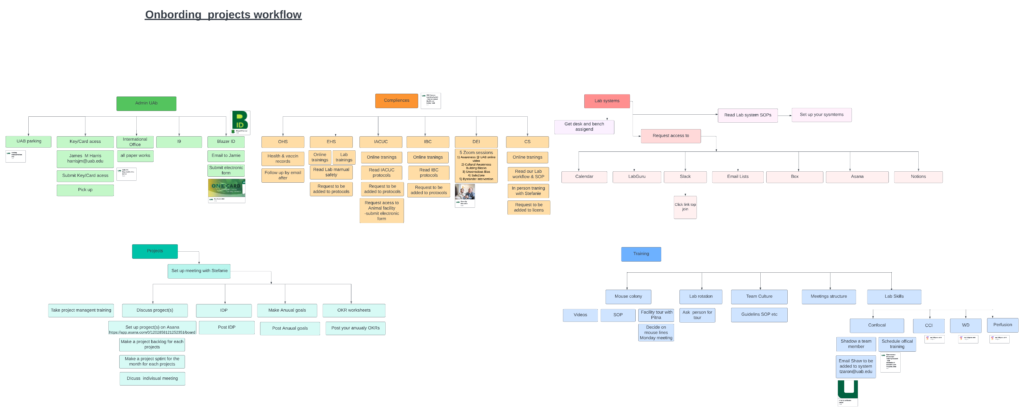by Stefanie Robel & Robert Roßbach
In the ever-evolving world of academic research, change is the only constant. This is the case for research teams even more so than in other environments because our workforce is composed mostly of trainees who will move to the next career stage, usually outside of our teams, in a few years.
Teams are dynamic entities, with members transitioning in and out. As a principal investigator, you take pride in seeing a team member leave for their next role, perhaps to start their own lab or to follow their dream in industry or biotech.
But with every exit comes a new beginning, and the cycle of onboarding begins anew.
The challenge? Ensuring that each new, enthusiastic member is integrated into your team, culture, and organization at all levels. This includes administrative requirements, compliance, and of course their project. But it doesn’t stop there: It’s just as important to emotionally and behaviorally integrate your new team member to ensure that your team culture is upheld.
And you want to do this without having to reinvent the onboarding wheel every time. This may not seem like a big deal when you first start your research program and your team grows relatively slowly with you being in the loop on almost every process (because you’ve just done it yourself). But soon it won’t be you doing some or most parts of integrating. This is when essential aspects of team knowledge, standards, and values get lost in translation—unless you standardized and documented your onboarding process.
Here’s a guide to ensure your new recruits hit the ground running.
1. Designate an Onboarding Specialist
Assigning a dedicated team member to oversee the onboarding process can be a game-changer. This individual, well-versed in the intricacies of your team and institution, can provide a structured and consistent onboarding experience. This also ensures that the newcomer feels welcomed, informed, and integrated. The onboarding pro acts as a consistent point of contact, answering questions and providing guidance. Of course you should consider choosing a team member who has been with the lab for a significant duration and has a good grasp of both the technical and cultural aspects. This person should be approachable, organized, and have a knack for teaching. This not only eases the transition for the newcomer but also ensures that you, as the PI, can focus on higher-level tasks.
Alternatively, you can divide up responsibilities for onboarding. For example, Stefanie’s process has so many parts that team members usually split them up when new team members join.
2. The Power of Contracts
Clarity is the cornerstone of any successful professional relationship. A contract sets clear expectations, reducing ambiguities and potential misunderstandings down the line. While contracts are typically associated with legalities and formalities, they can also serve as powerful tools for setting clear expectations. Consider creating a team contract in addition to the legal contract that HR takes care of. This contract can be part of your lab manual and include expectations around work hours, interactions between team members, who needs to be informed with how much notice about time off, routine tasks within the team, role responsibilities, publication and authorship policies,, presentation schedules, and both personal and professional development. If there are specific lab protocols regarding data storage or equipment usage, include them. A signed contract not only formalizes the onboarding process but also fosters a deeper commitment from the new team member.
3. Peer ‘Buddies’ in Addition to You as Mentor
While mentors offer invaluable guidance and support, peers or ‘buddies’ can be more effective during the onboarding phase. The initial days in a new environment can be overwhelming. Having a peer buddy can make this transition smoother. They offer a relatable perspective, making the newcomer feel less isolated. Encourage regular check-ins between the buddy and the new member. For instance, they could have weekly coffee chats to discuss any challenges or questions. This informal setting can lead to more open communication and quicker problem resolution. New team members often find it easier to relate to and learn from peers who have recently undergone similar experiences. These buddies can provide insights into common challenges, lab techniques, and institutional nuances that senior members might overlook.
4. Standard Operating Procedures (SOP) and Checklists
Documenting the onboarding process is crucial for consistency and efficiency. An SOP ensures that every team member, irrespective of when they join, receives the same onboarding experience. Create a detailed SOP that outlines each step of the onboarding journey, complete with a timeline. For instance, tasks like securing an access card can be initiated even before the new member’s official start date (unless you work at Stefanie’s university, then you’re out of luck with this kind of efficiency).
The SOP should be a living document, updated regularly based on feedback and changing lab dynamics. The checklists can be digital, allowing for real-time updates. Tools like Trello or Asana can be used to track onboarding progress. Also check out Stefanie’s example of a flowchart with live links to document an onboarding process with many steps.

We provide this to new team members and assign a buddy for each category. It serves as a checklist and orientation to keep track of all the moving parts.
Additionally, develop two checklists: one for the onboarding specialist and another for the new recruit. These lists ensure that both parties are aligned, and the onboarding process isn’t deemed complete until every box is checked.
5. Swift Integration is Key
A sense of belonging can significantly impact a new member’s productivity and commitment. Swift integration ensures that they feel part of the team from day one. Building rapport and fostering this sense of belonging are essential for any new team member. If feasible, organize an informal gathering or team event before the newcomer’s official start date. This provides an opportunity for the entire team to connect, facilitating smoother interpersonal dynamics once work commences.
During team meetings encourage team members to share a bit about their work, fostering collaboration. You can also consider creating a platform (like a team newsletter or a bulletin board) where newcomers can share a bit about themselves, their academic journey, and their interests outside of work.
Every lab has its own unique culture. Share stories, traditions, or even fun facts about the team. This not only educates the newcomer but also makes them feel part of the lab’s legacy.
6. Think beyond the first day
A development plan for new team members is essential. It provides them with clear role expectations, essential skill development pathways, and a timeline of key milestones. Starting with a comprehensive onboarding, the plan emphasizes regular check-ins and collaborative learning, fostering a culture of knowledge sharing.
After the initial 100 days, a feedback session becomes pivotal. This juncture offers insights into the member’s achievements, areas for improvement, and their overall experience. By doing so, principal investigators ensure that their team members are not only integrated but also empowered for future successes.
The onboarding process, while seemingly administrative, plays a pivotal role in setting the tone for a new team member’s journey. A well-structured, thoughtful onboarding experience not only ensures that the newcomer is equipped with the necessary tools and knowledge but also fosters a sense of belonging and commitment. As PIs, while our primary focus might be on groundbreaking research, it’s essential to remember that the success of our endeavors is deeply intertwined with the well-being and integration of every single team member.
Happy leading!
–Stefanie & Robert
P.S.: Unlock the next level of research leadership. This September, we’re launching a new cohort for our Research Leadership Mastery Program. Join our community and redefine what it means to lead in the world of research.







